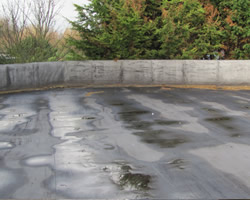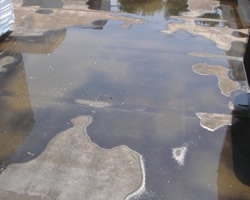Flat Roof Series 1: The Problems Associated with Flat Roofs
As we continue broadening our horizons in the world of roofing, we turn to flat roofs. Roofs with little-to-no pitch (slope) are commonplace among commercial buildings, but are also present in some residential buildings. First up in our series, we examine the major potential problems associated with flat roofs.
Poor Water Flow
 Architecturally speaking, there is a good reason to install a slanted roof: rain, snow and other elements of weather can simply slide down them. Since flat roofs are, well, flat, they require more intricate water drainage and gutter systems. Controlling water flow on flat roofs is not nearly as easy as it is with sloped roofs. An improperly installed flat roof will almost always entail the accumulation (ponding) of water and ensuing leakage. When water does not run off the roof, bad [costly] things happen.
Architecturally speaking, there is a good reason to install a slanted roof: rain, snow and other elements of weather can simply slide down them. Since flat roofs are, well, flat, they require more intricate water drainage and gutter systems. Controlling water flow on flat roofs is not nearly as easy as it is with sloped roofs. An improperly installed flat roof will almost always entail the accumulation (ponding) of water and ensuing leakage. When water does not run off the roof, bad [costly] things happen.
Proper drainage must be in place to get rid of water accumulation on a roof. Older flat roofs are typically not leveled, and water puddles will cover different areas of the rooftop after every rain and sit until it dries out. In some cases a tapered insulation system or internal drains must be added to allow for proper water flow from your building to ensure the longevity of your roofing system.
Voided Flat Roof Warranty
 Most roofing systems were not designed to accommodate for ponding water. In fact, most manufacturers of the roofing systems on the market today will void out the warranty if there is ponding water on the roof. That means you could be left paying for any repairs. Make sure if your roof in under warranty that you follow the manufacturers maintenance plan and only allow a certified contractor of the roofing system make any repairs with the knowledge of the manufacturer.
Most roofing systems were not designed to accommodate for ponding water. In fact, most manufacturers of the roofing systems on the market today will void out the warranty if there is ponding water on the roof. That means you could be left paying for any repairs. Make sure if your roof in under warranty that you follow the manufacturers maintenance plan and only allow a certified contractor of the roofing system make any repairs with the knowledge of the manufacturer.
Why does my flat roof leak?
Seams exist on every flat roof (except tiny ’6×10 porch-type’ roofs, which can be covered with a single sheet of roofing membrane) and are usually put together with an adhesive. After a few years, the adhesive breaks as a result of significant weather changes (here in the Midwest, temperatures can fluctuate greatly in the span of 24 hours).
Another major factor affecting adhesiveness is condensation, which occurs underneath the roof covering. Condensation expands both in the winter and summer. The most dramatic expansion of condensation happens in the colder months when water freezes, expands, and breaks the seam. The same process gives us those wonderful potholes on our roads. Heat can be equally damaging to a roof’s integrity. In the summer, water heats and expands. Bubbles on the roof’s surface are an indication of water vapor lifting the membrane.
The third major factor centers on the quality of workmanship and the adhesive used. For different roofing systems the process is different, but most of them share the same shortcoming–the need to use adhesives in the first place, be it glue, hot tar, liquid resin, etc. Adhesives are also required to flash any roof penetrations listed above. The type of adhesive, the process of applying it, and the experience of the contractor all play a crucial role in ensuring that a flat roof is properly installed. Also any and all penetrations to the roof area typically will fail prior to the roof system itself failing. This includes HVAC units and all points of termination ( where the roof ends and must be terminated) A topic of contention between roofing contractors and HVAC contractors can be who’s to blame for the leak? This can easily be resolved with a water test of the roof and the accompanying HVAC units. In some cases it can be that a loose screw was left next to a unit and stepped on, or that a flock of geese, raccoon’s, squirrels or some other type of animal decided to pay a visit to your roof and cause major damage! Roofing contractors are typically the first one to blame anytime water enters the roof of a building which is just not fair and not always the case!
[nggallery id=5]
So with all that being stated, before you consider replacing your flat roof- Make sure the proper type is chosen and a proven reputable roofing contractor installs it for you!
Okay, so with the potential problems flat roofs face, why on Earth would any sane person choose to go with a Flat Roof? Read our next segment to learn about the Advantages of Flat Roofs!


